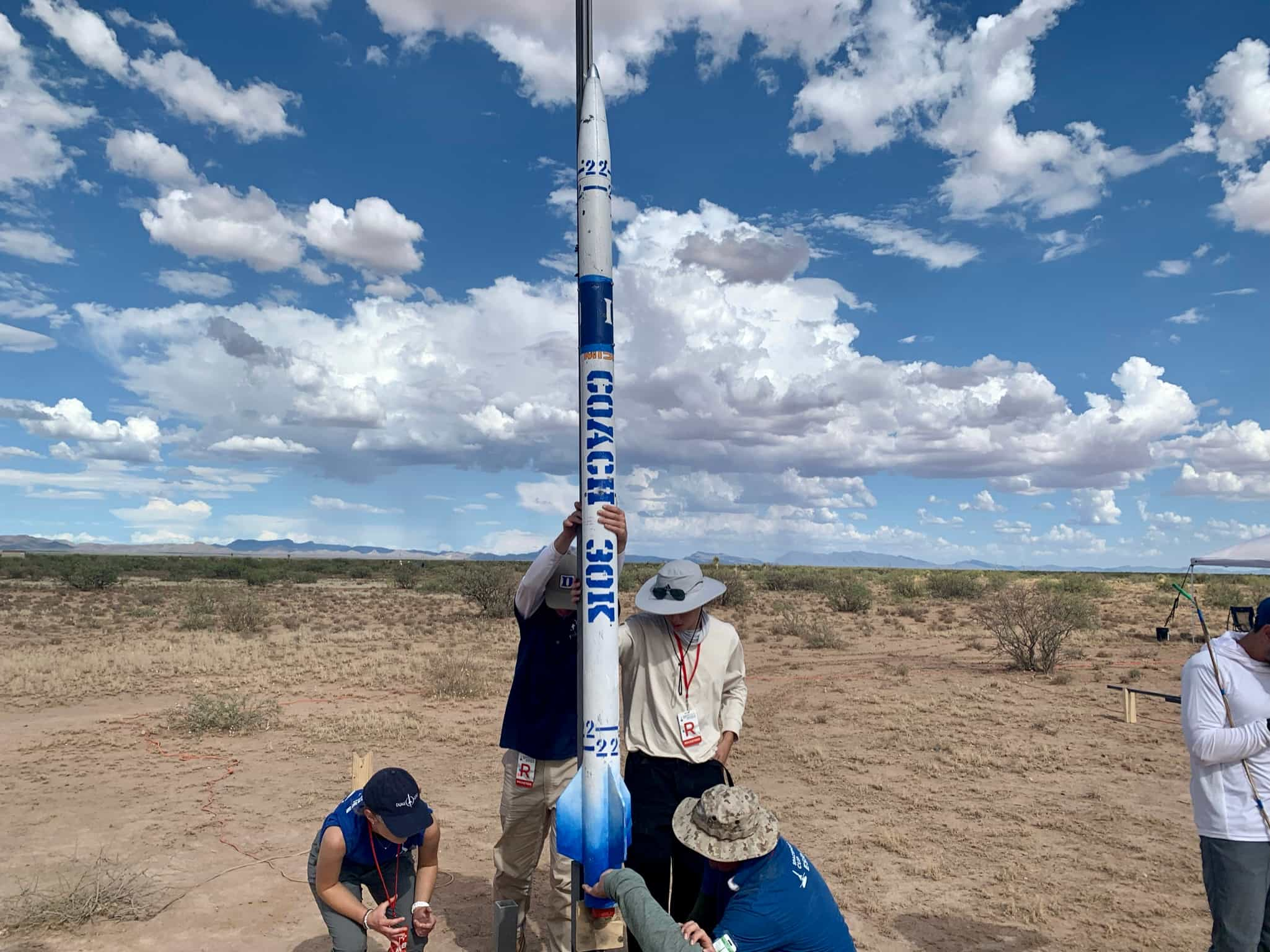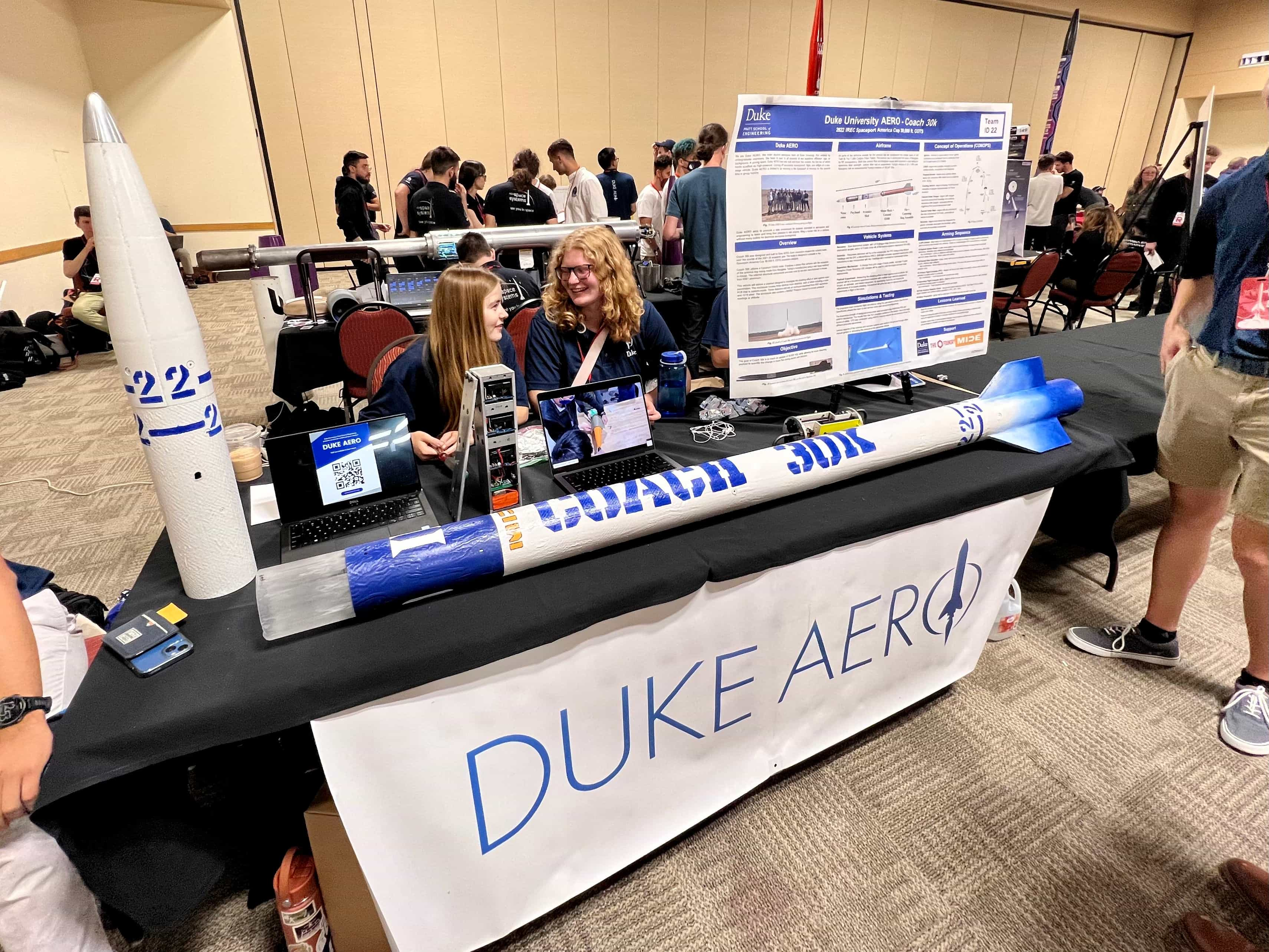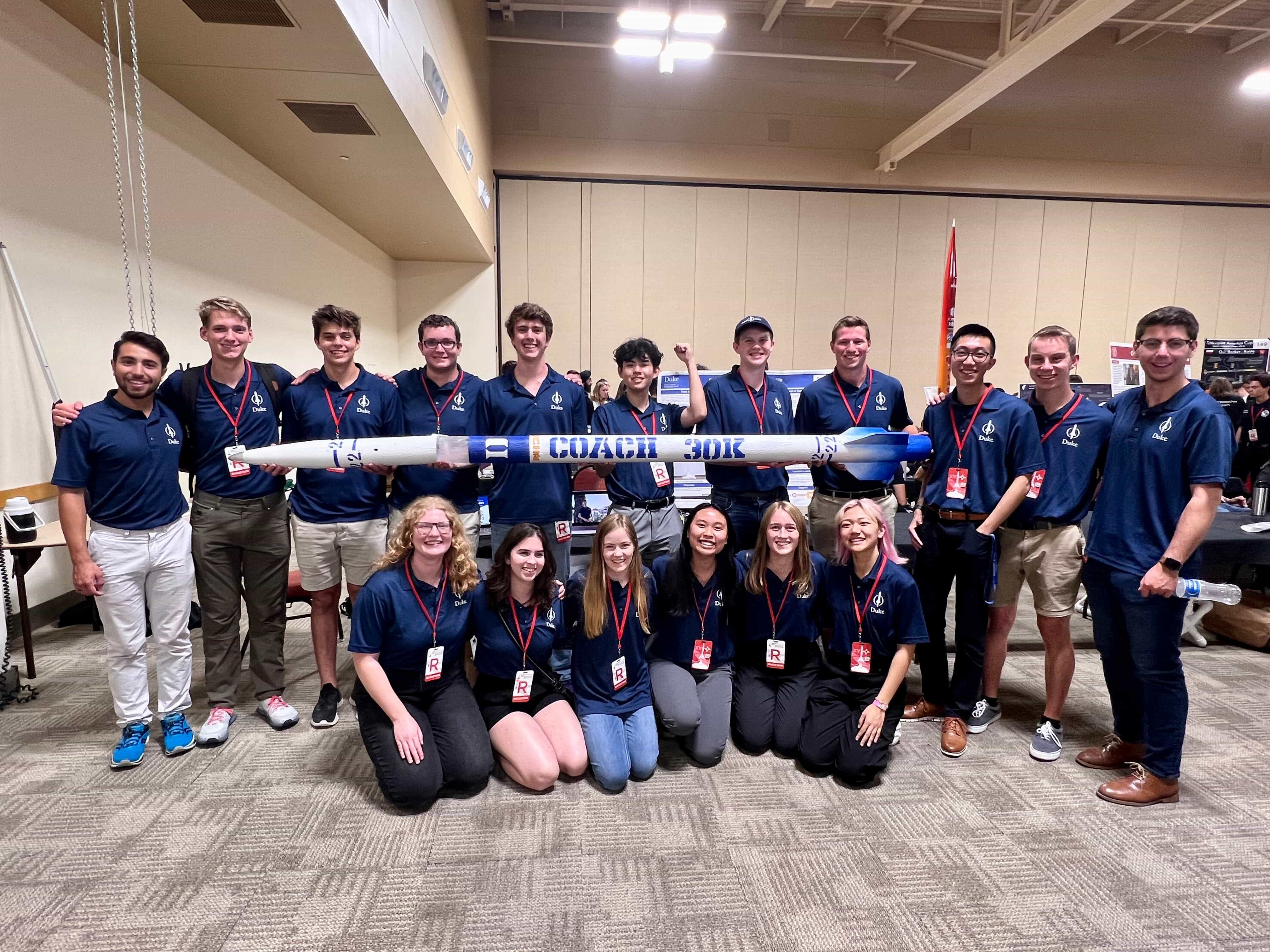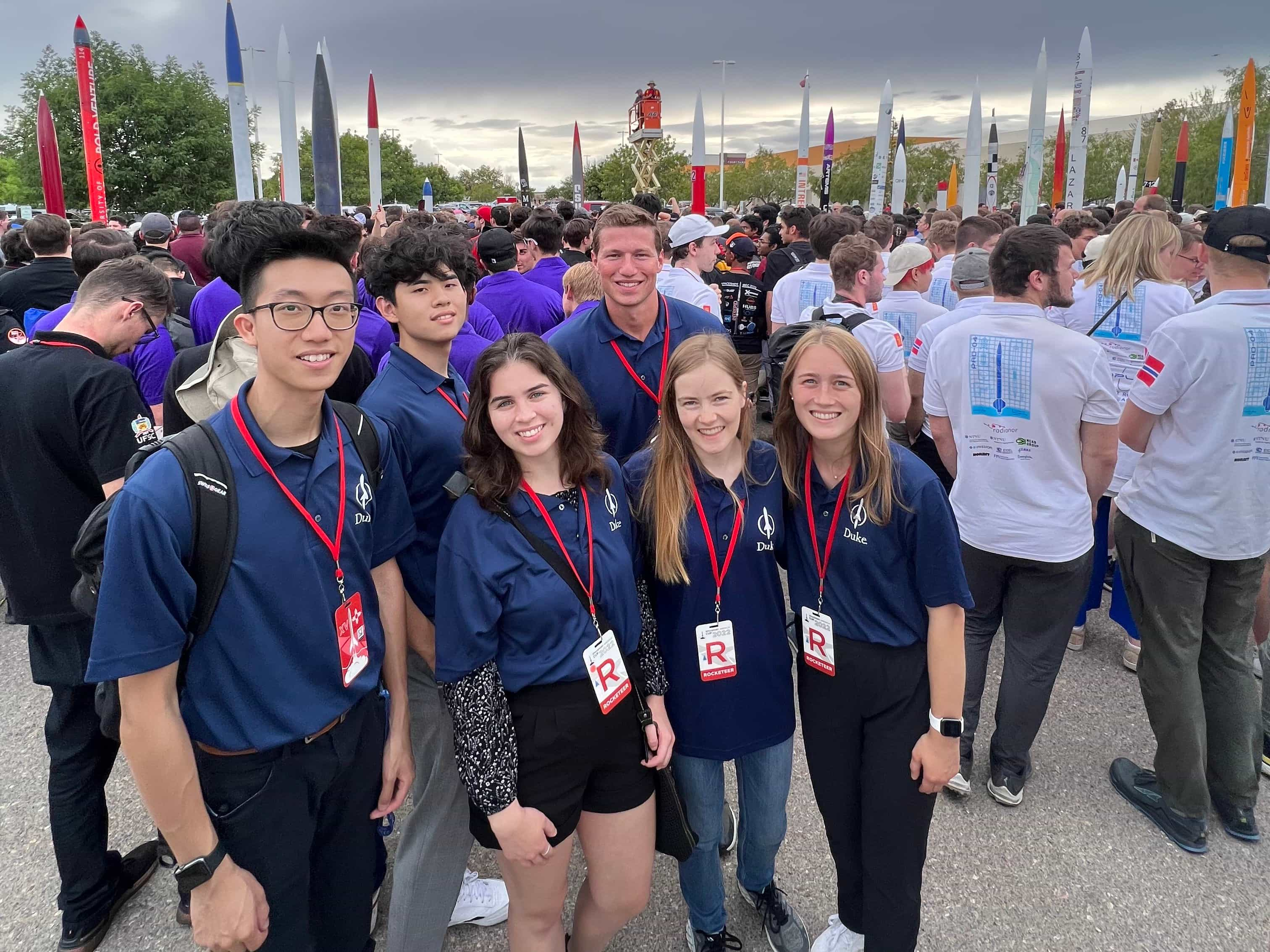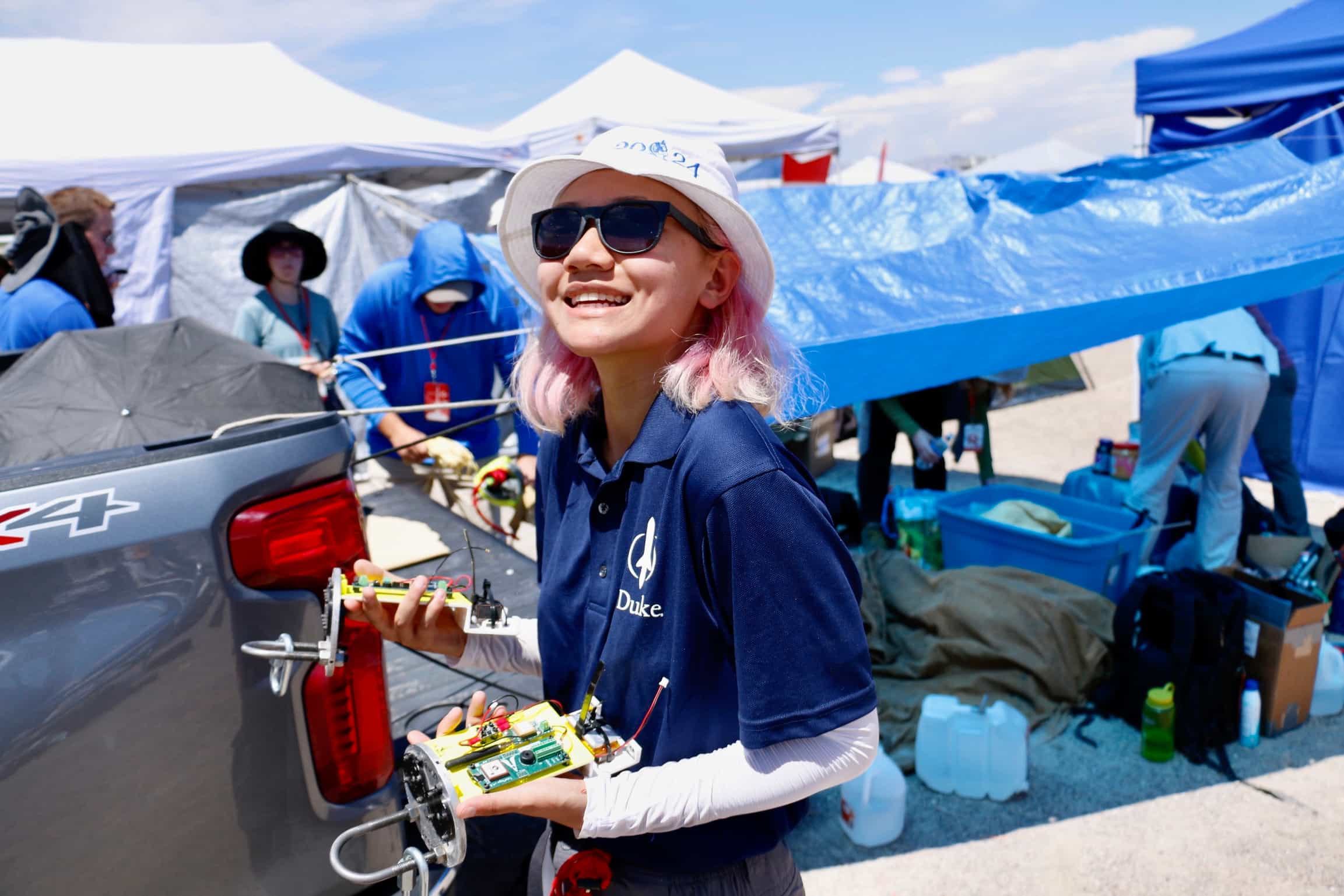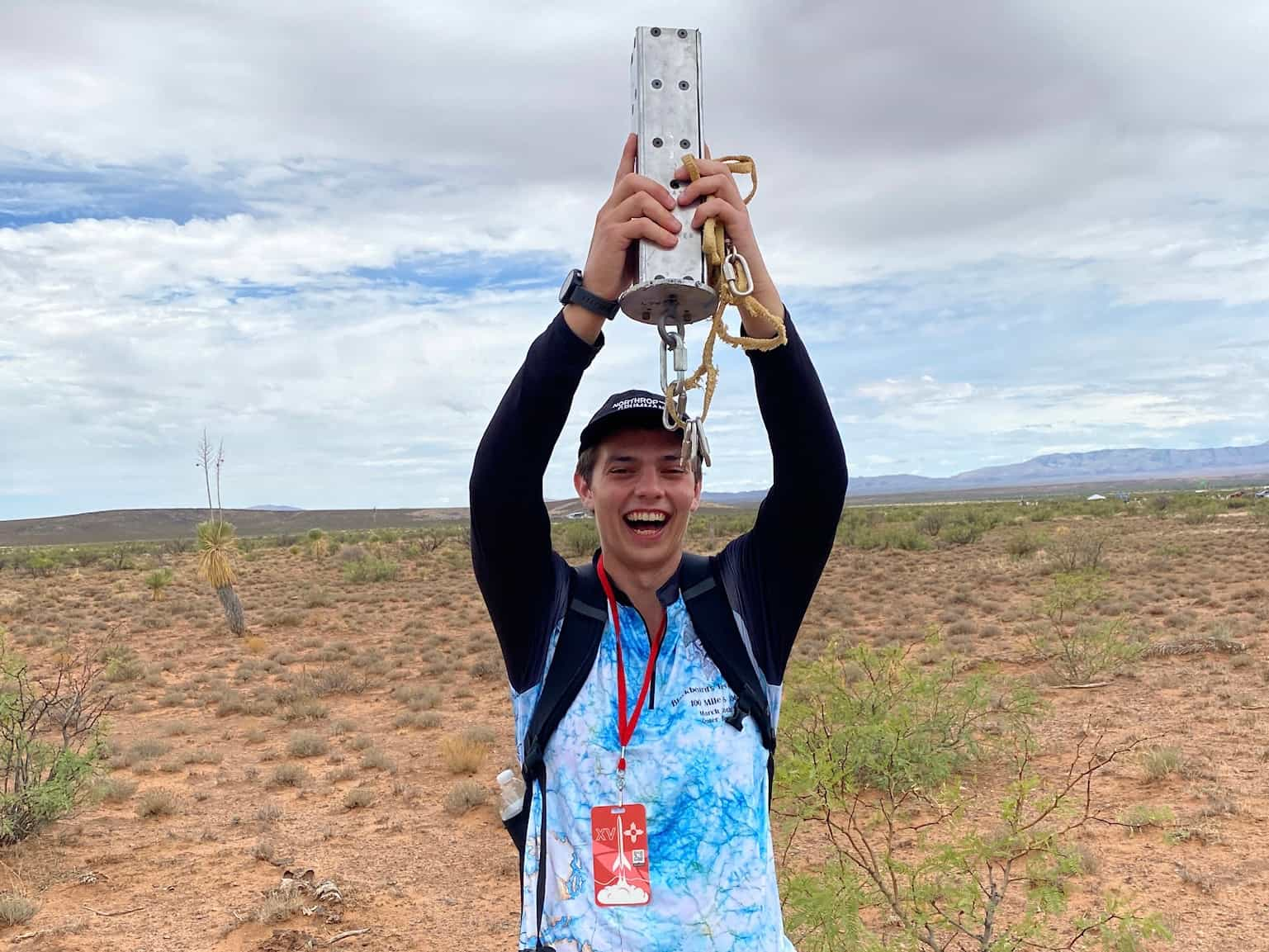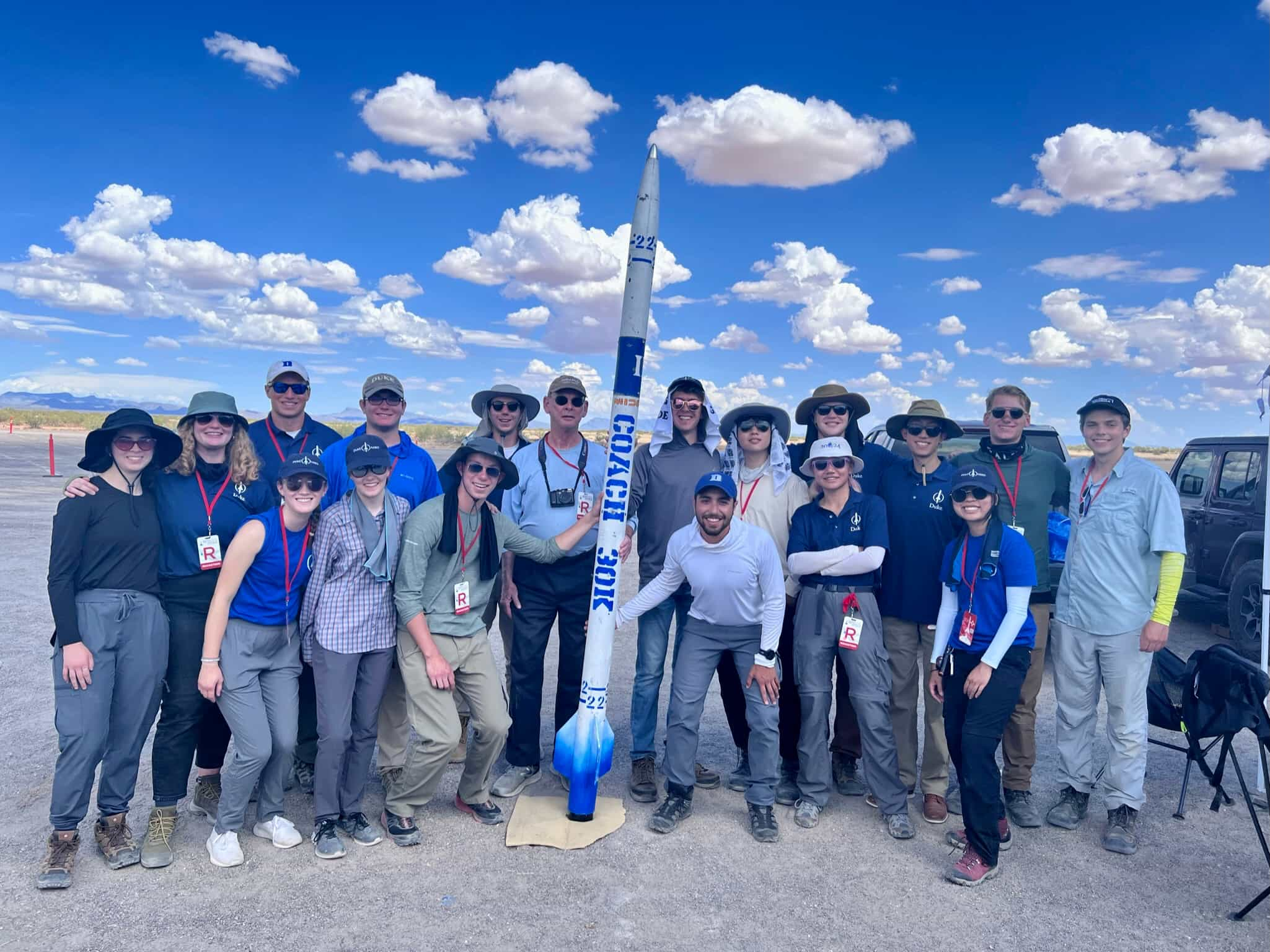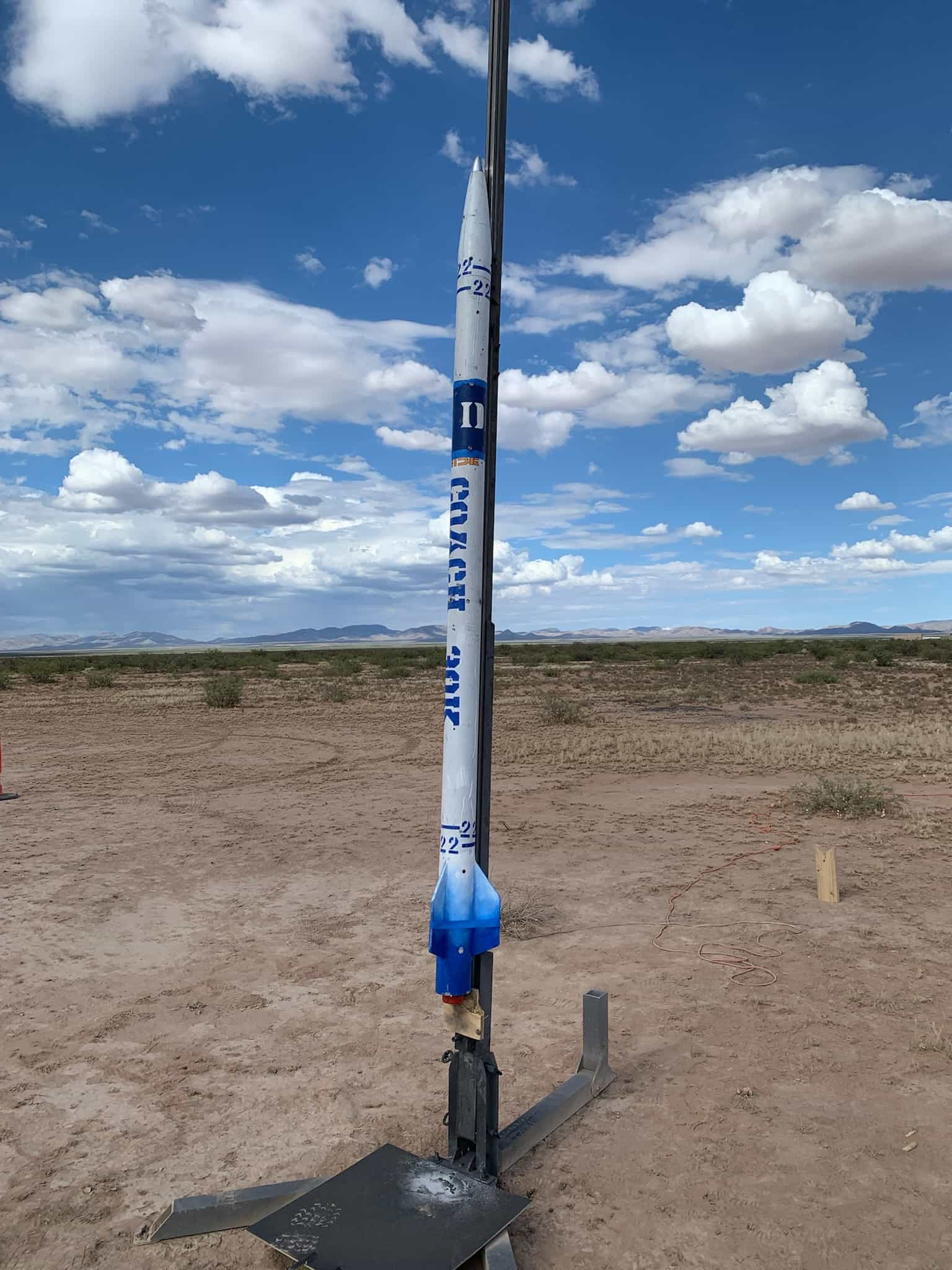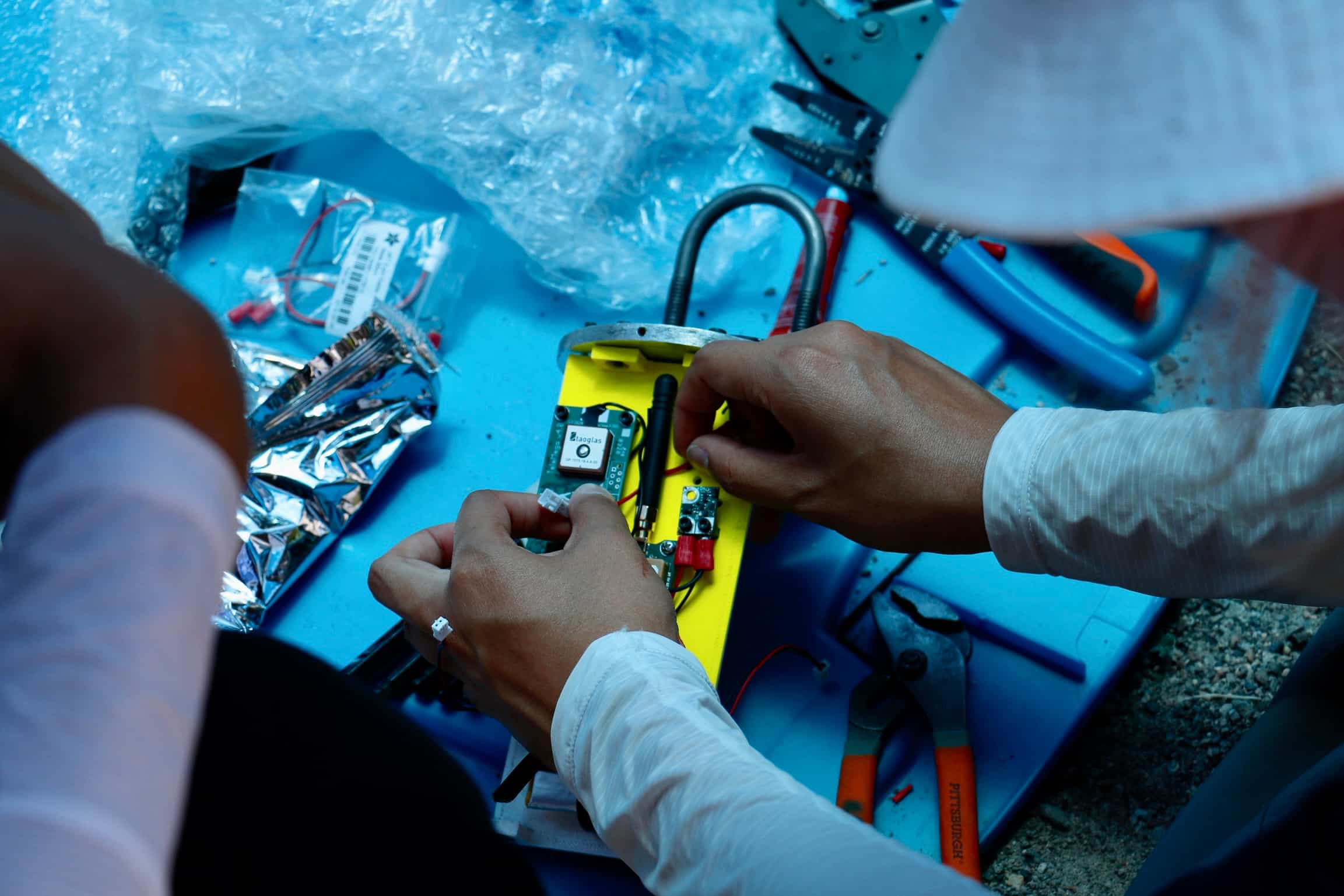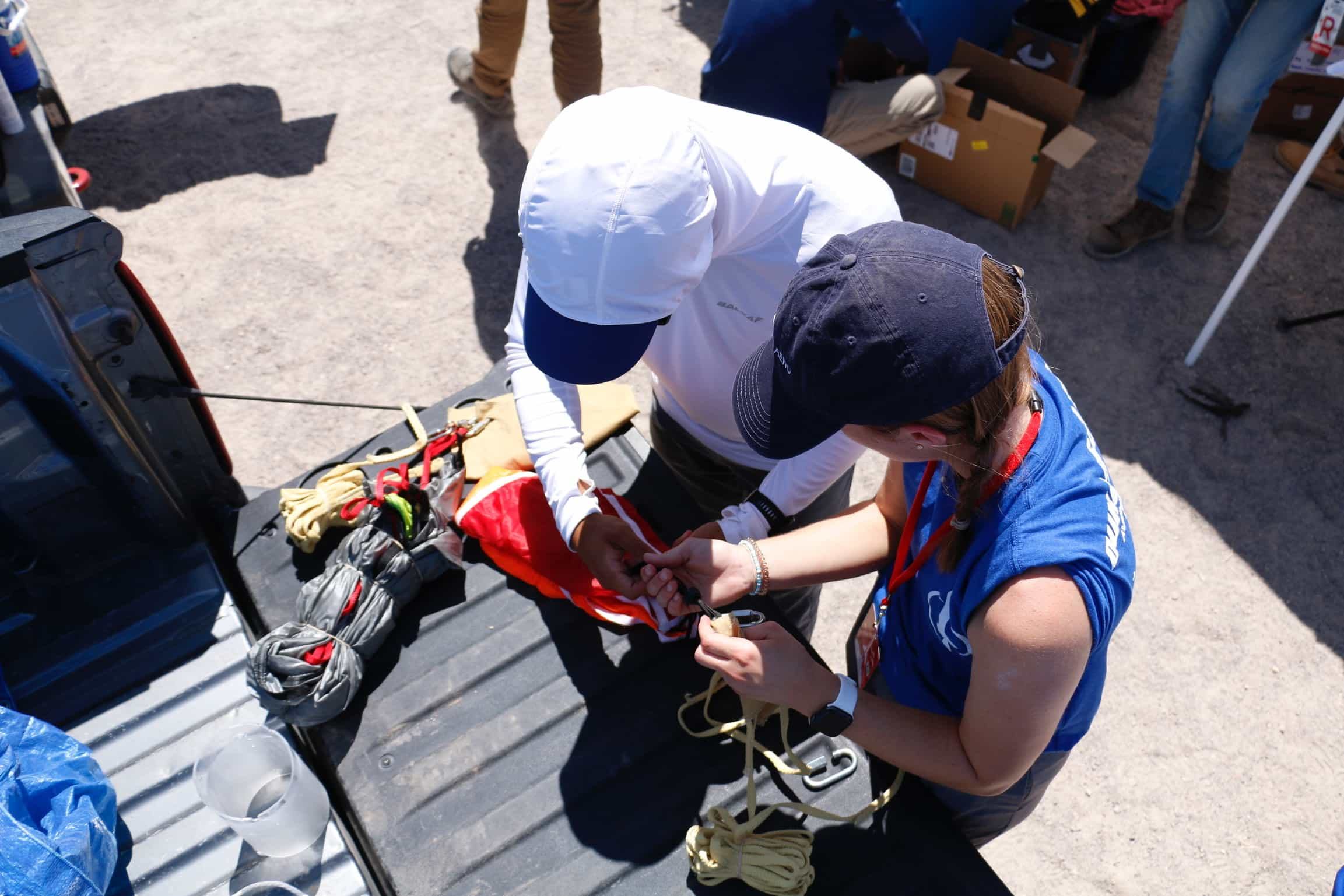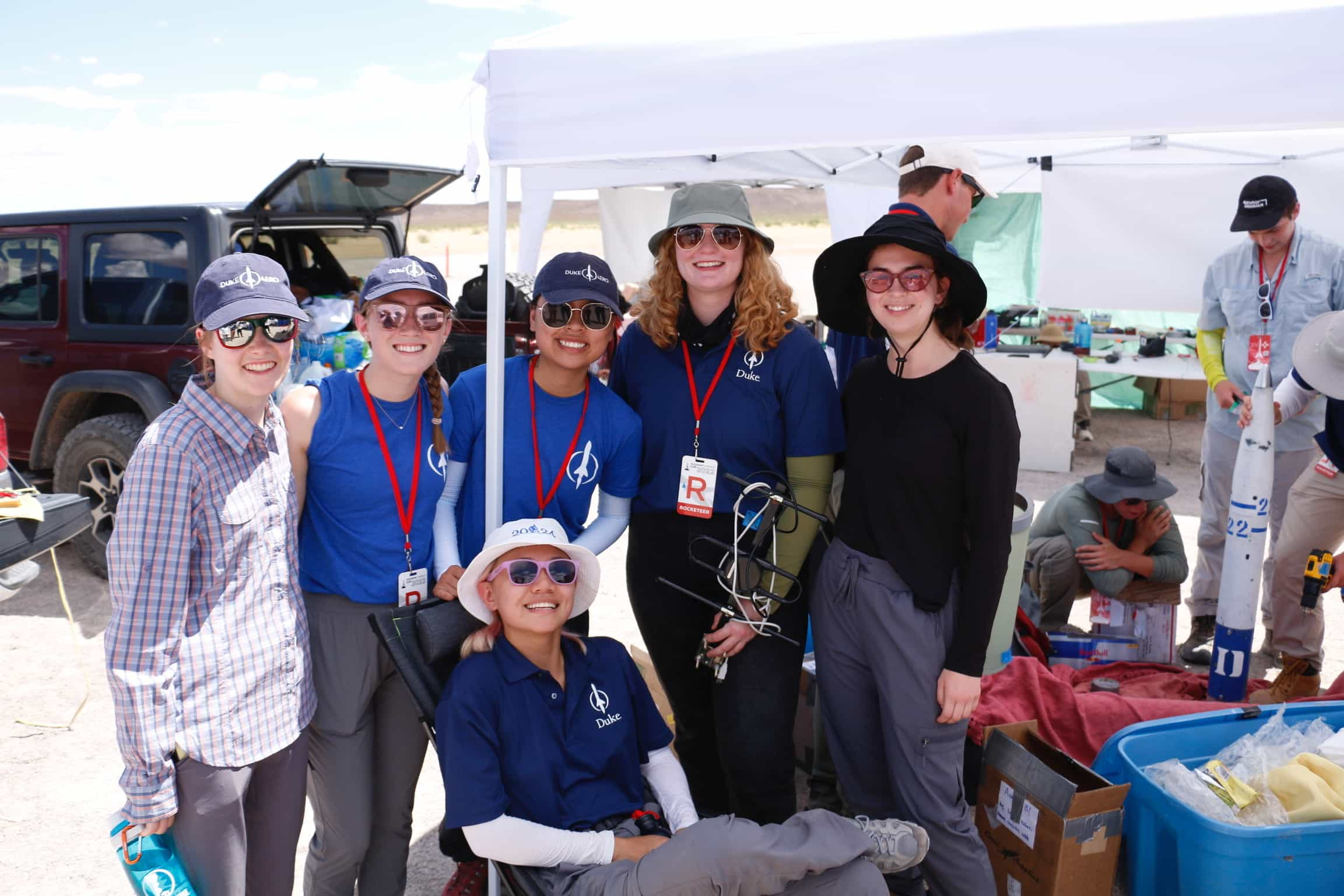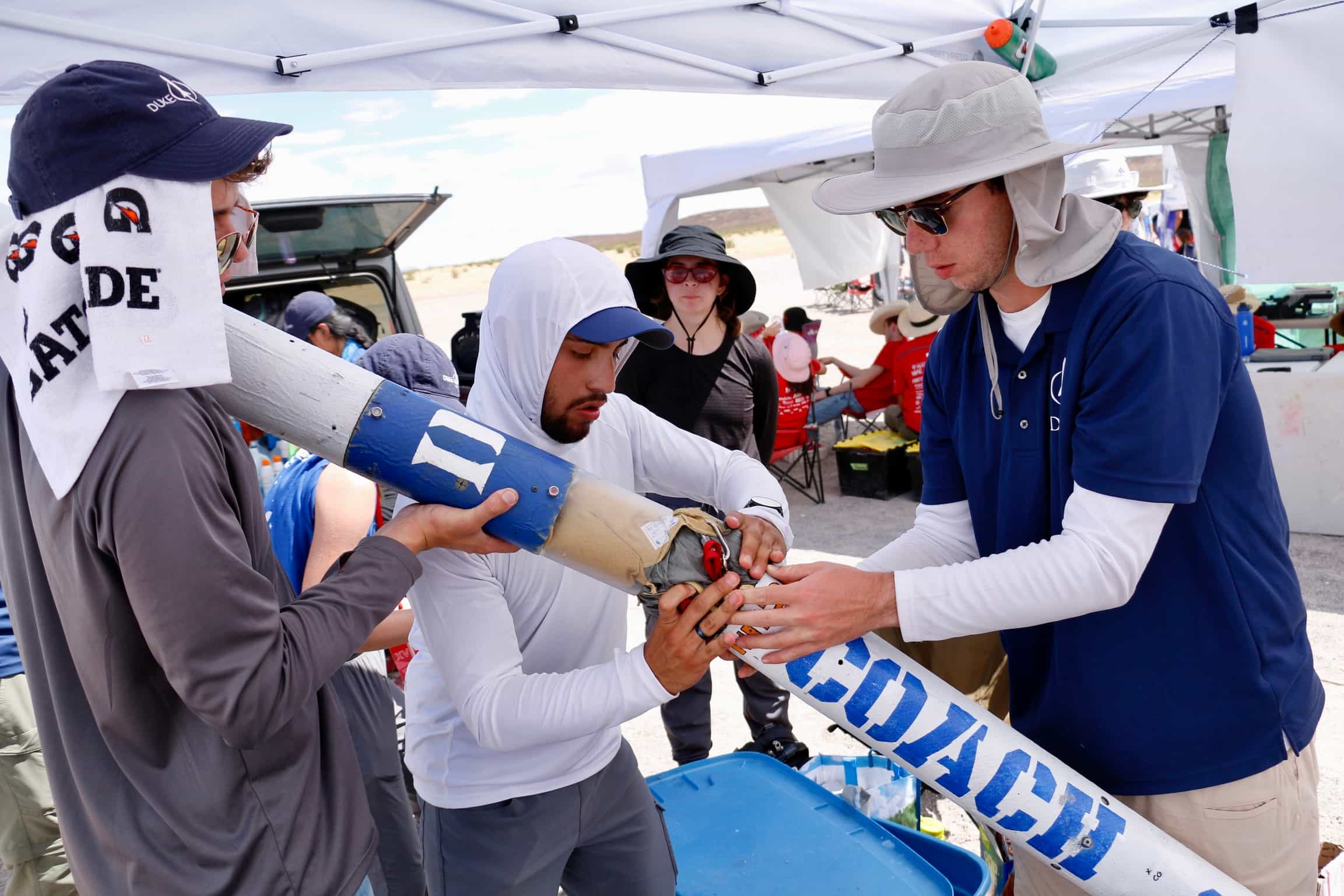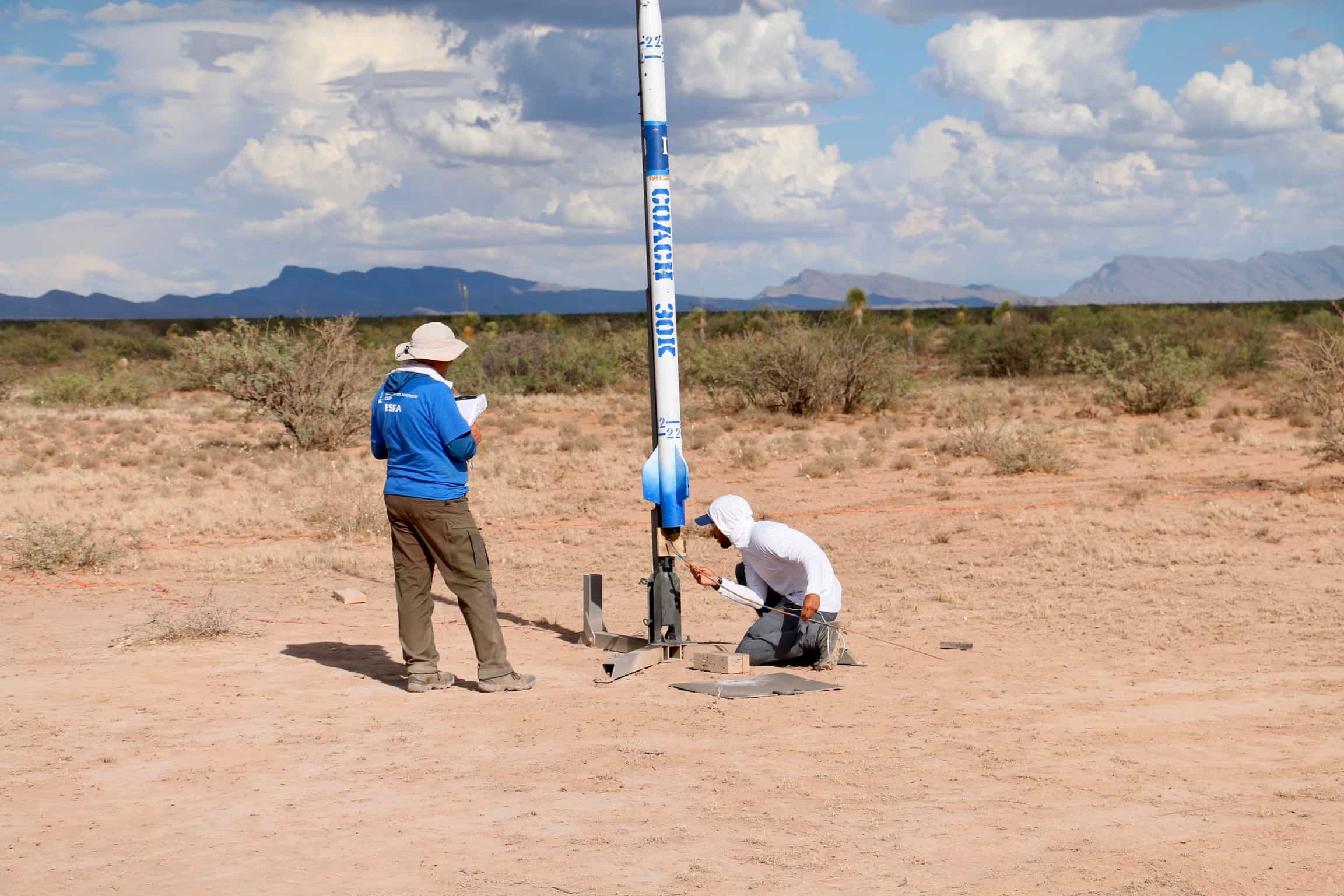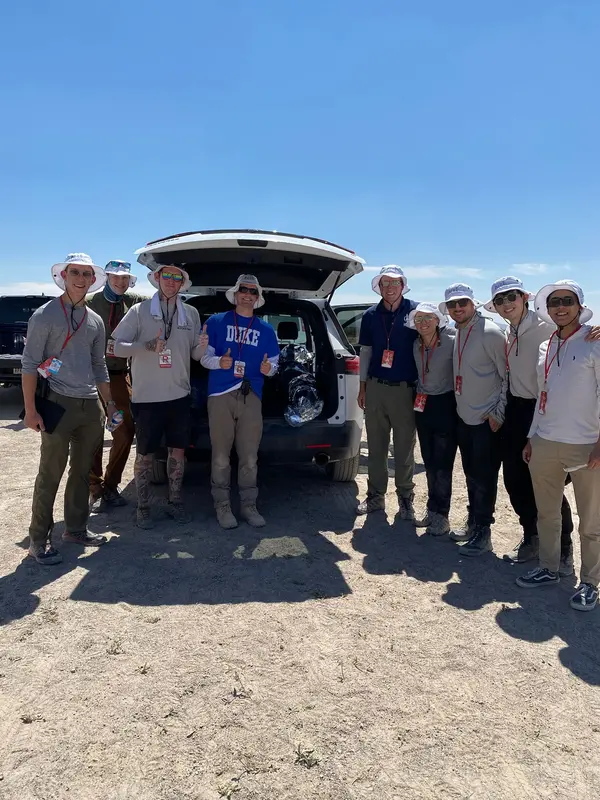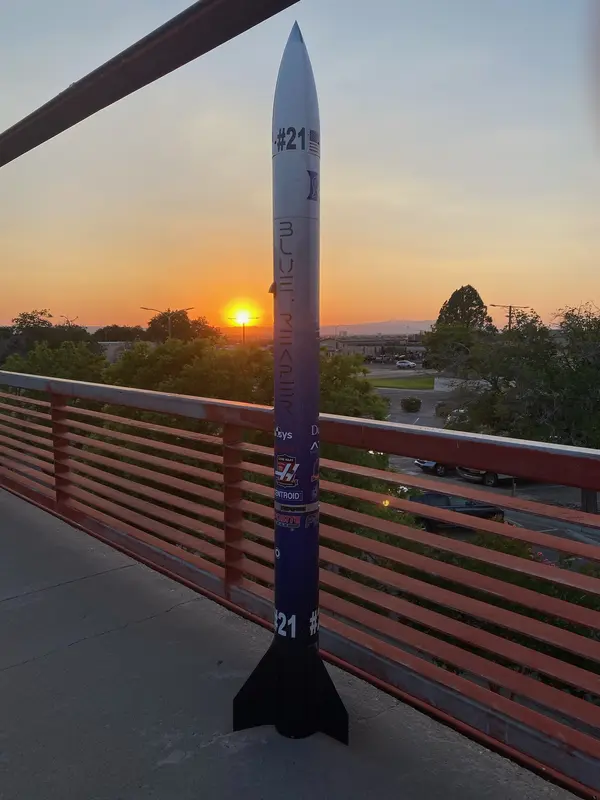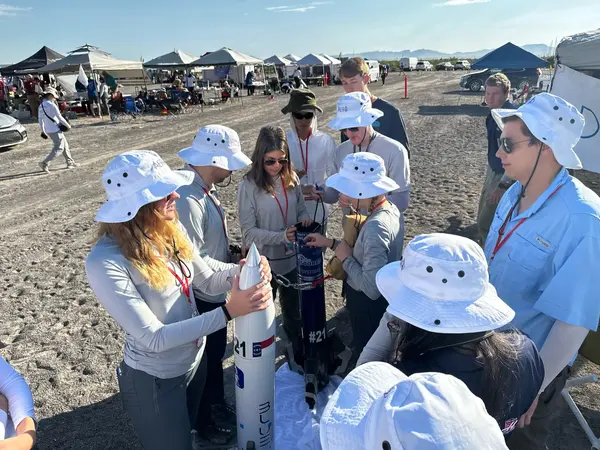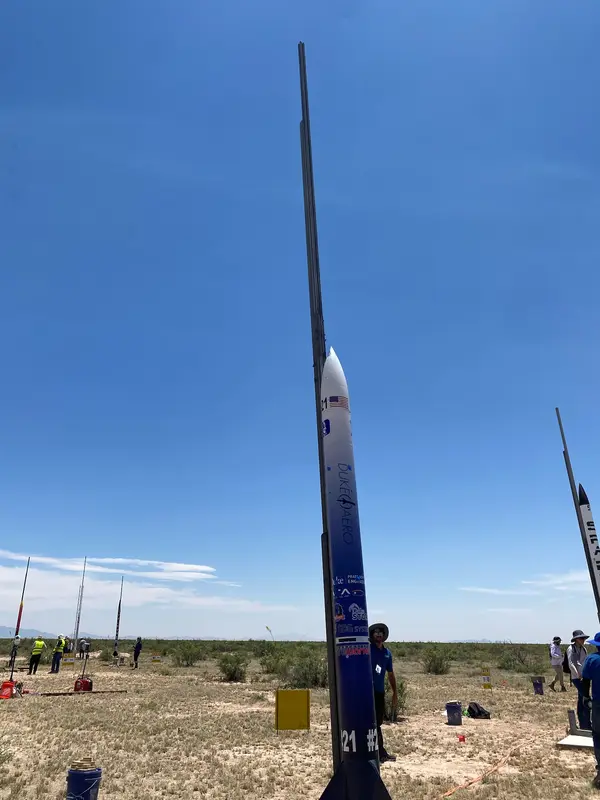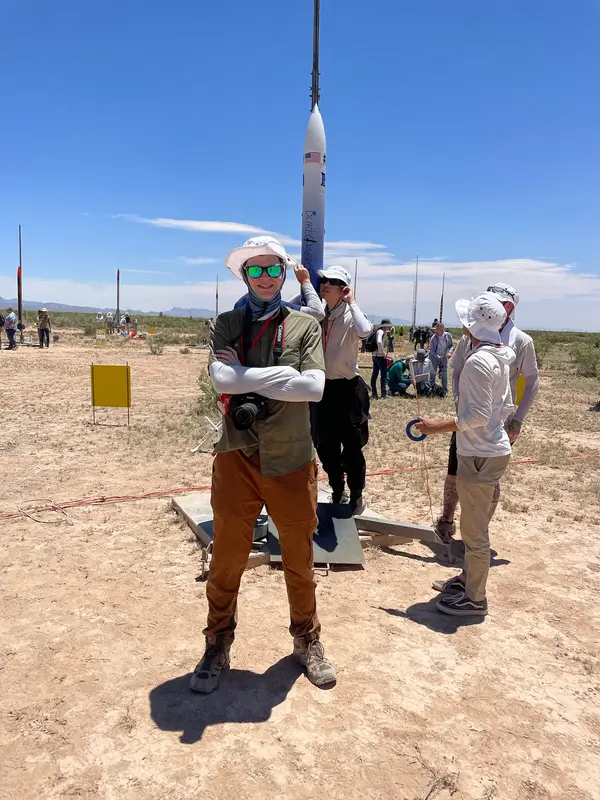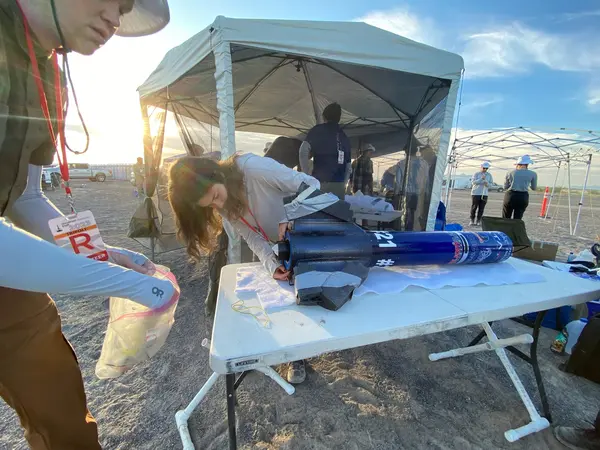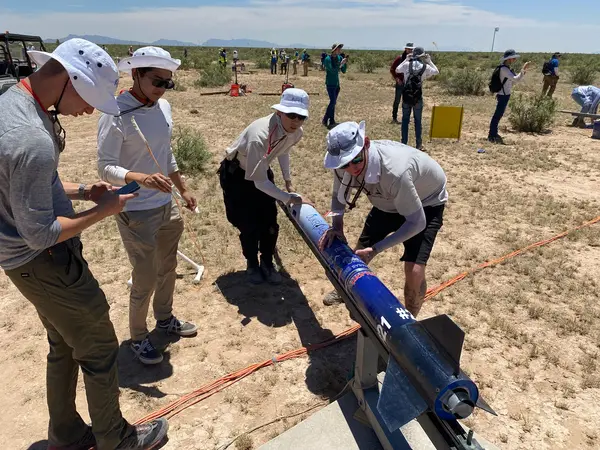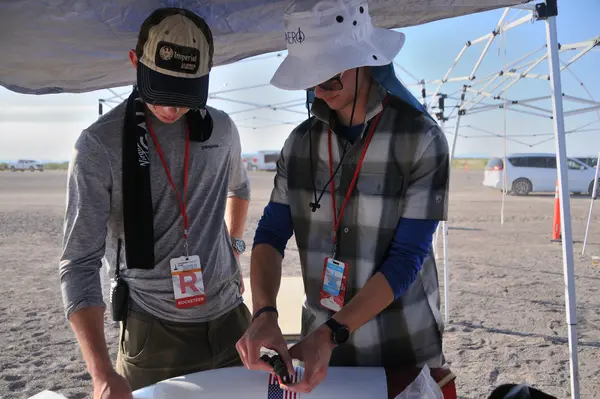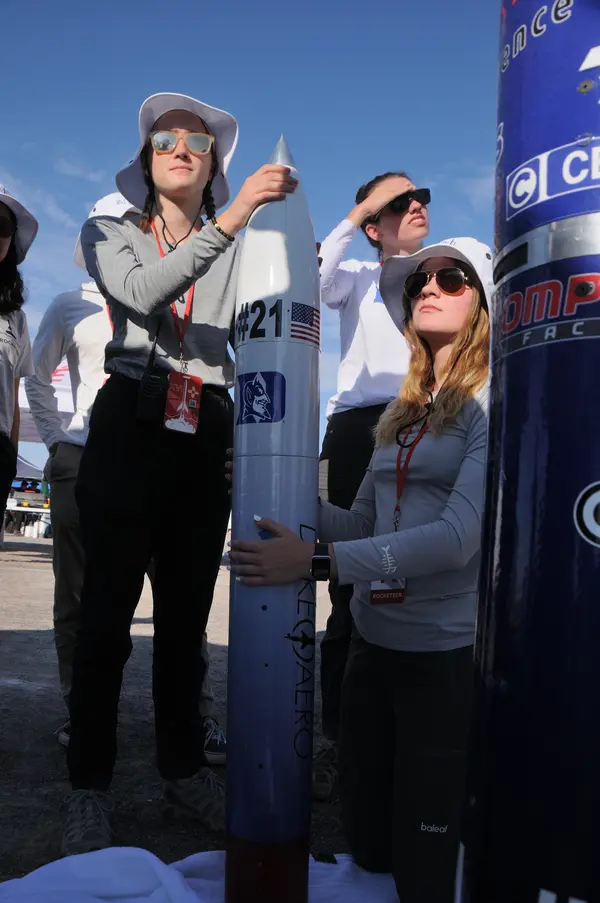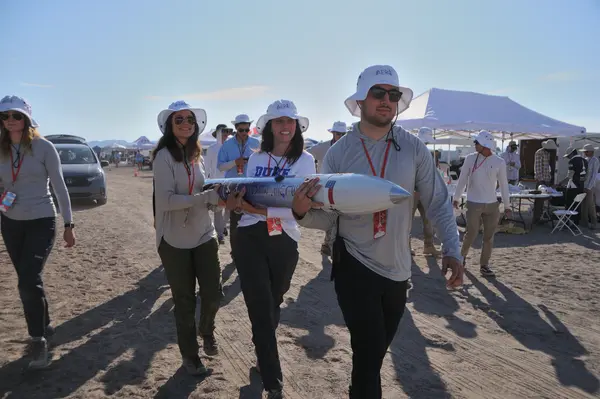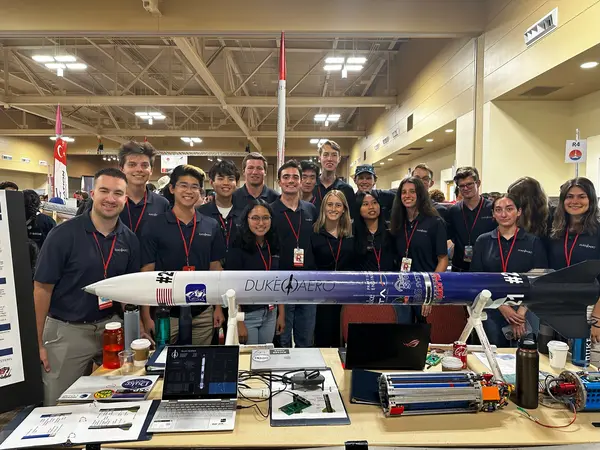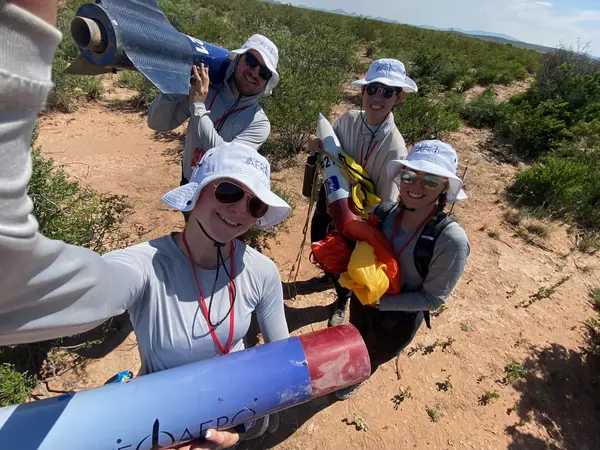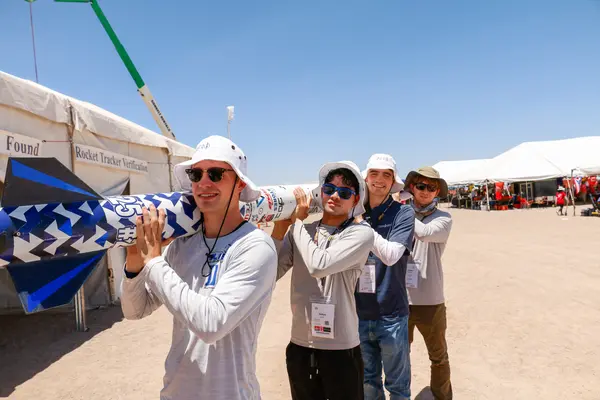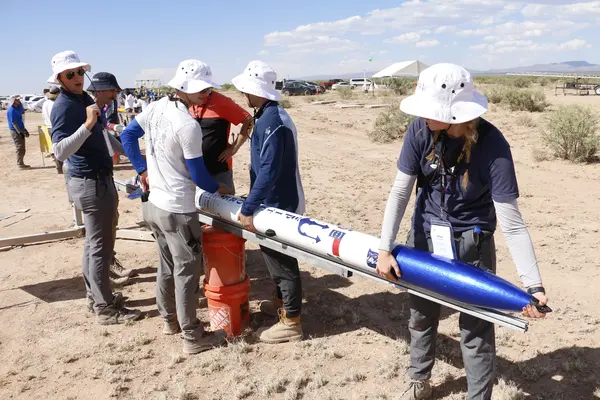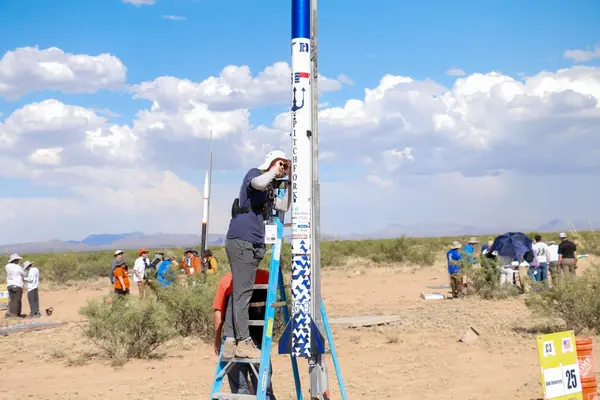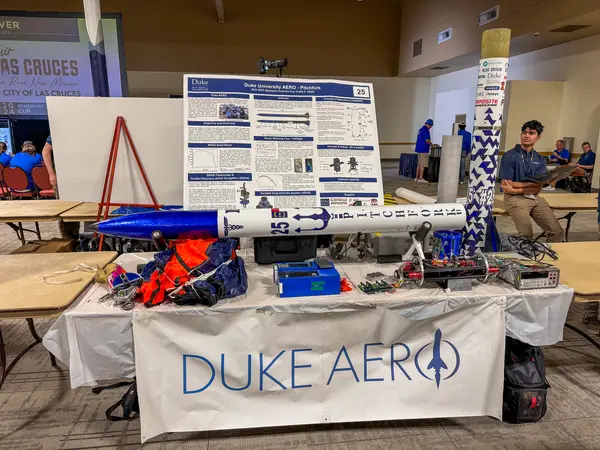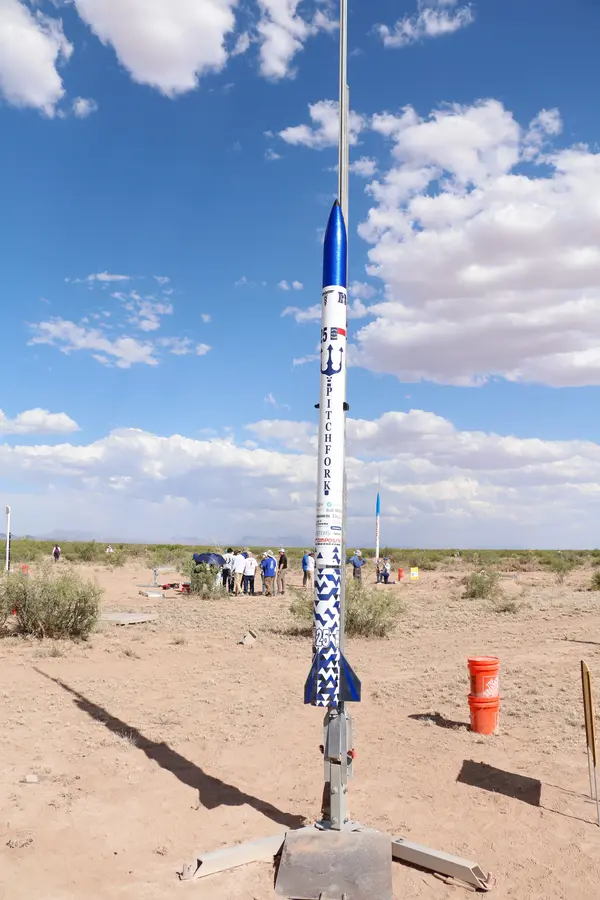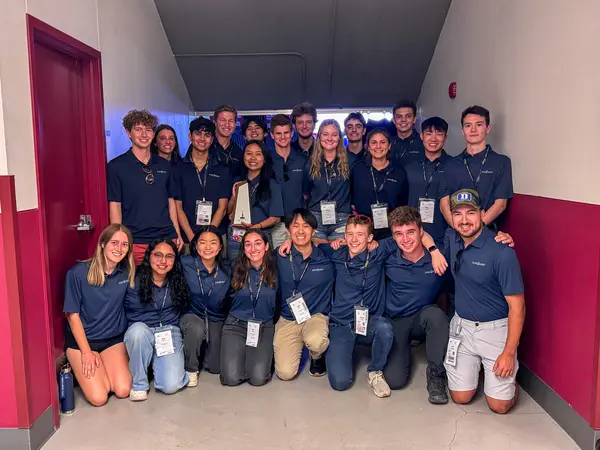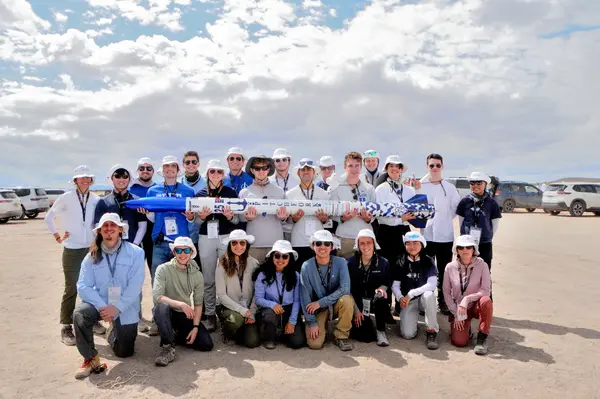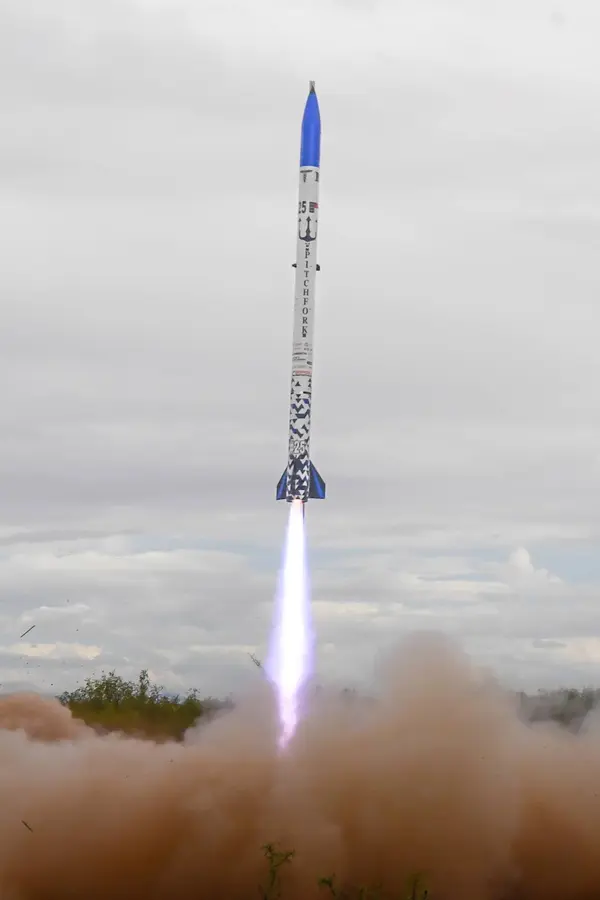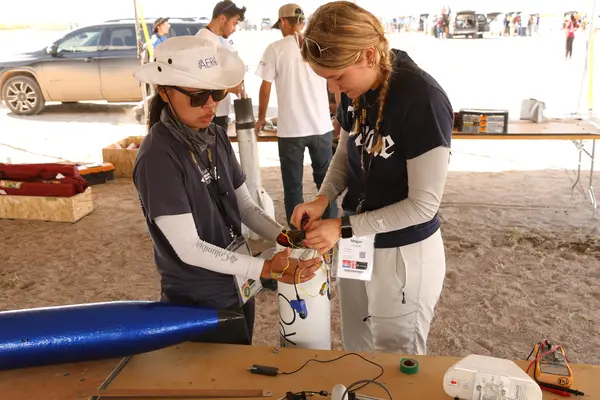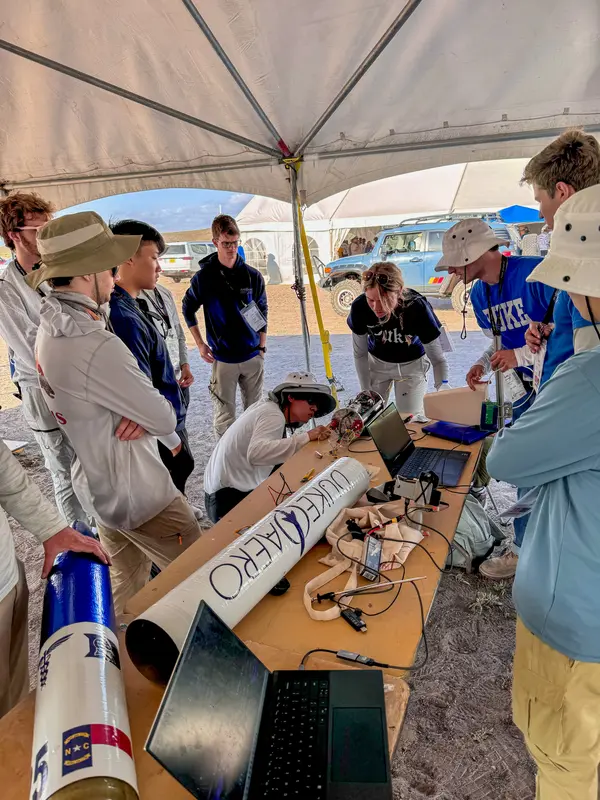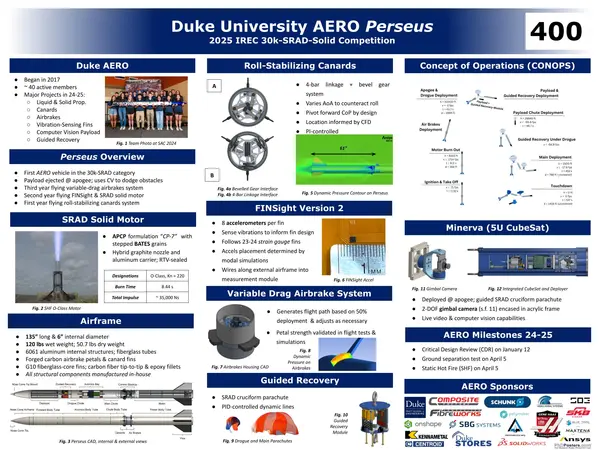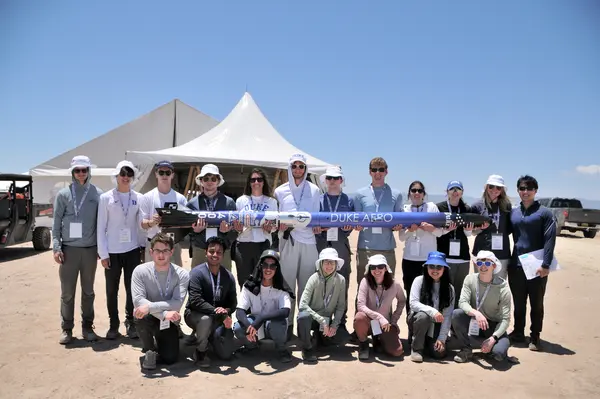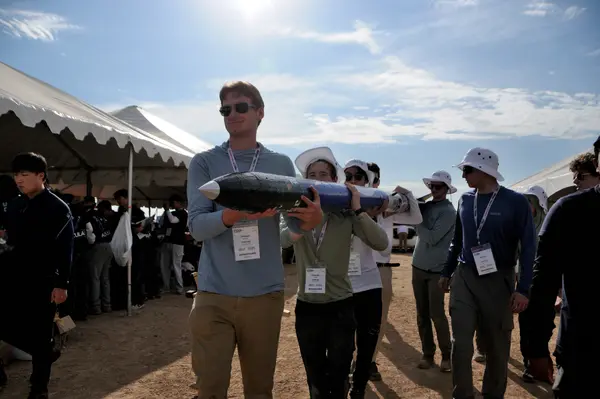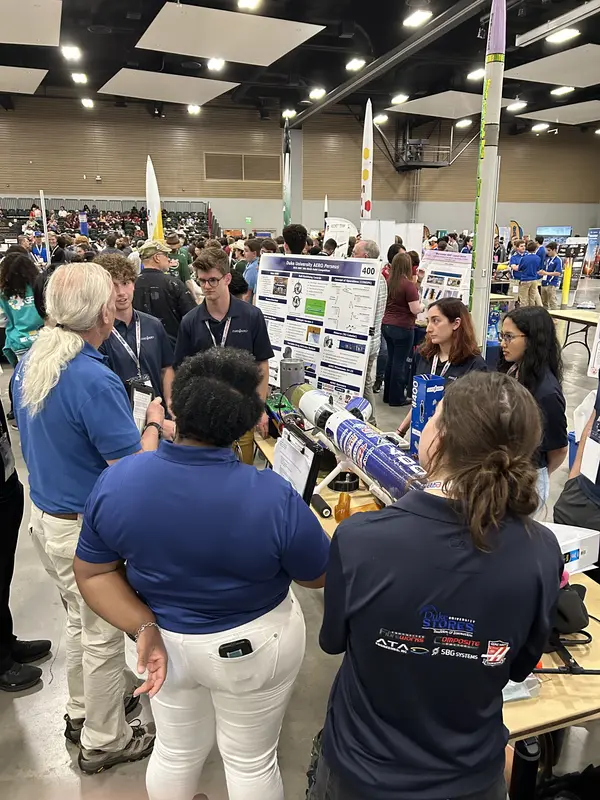BLUESTONE (2018-2019)
Building a History
Designed during the 2018/19 academic year for a low altitude flight at the Bayboro Launch Facility in NC, Bluestone marked a significant milestone for Duke AERO in its design and fabrication. Up until Bluestone we had established a history of constructing small low-powered rockets, a trend which Bluestone shattered. At a length of over 9 feet and a weight close to 90 pounds, Bluestone blew through our highest expectations in altitude, speed, and stability. However, with every great advancement comes a setback, and loss of avionics tracking near apogee led to an inability to recover the rocket. A drastic step up in power and performance, Bluestone marked Duke AERO’s first rocket with established goals and success criteria, and paved the way for our future projects with bigger, heavier, and more powerful vehicles.
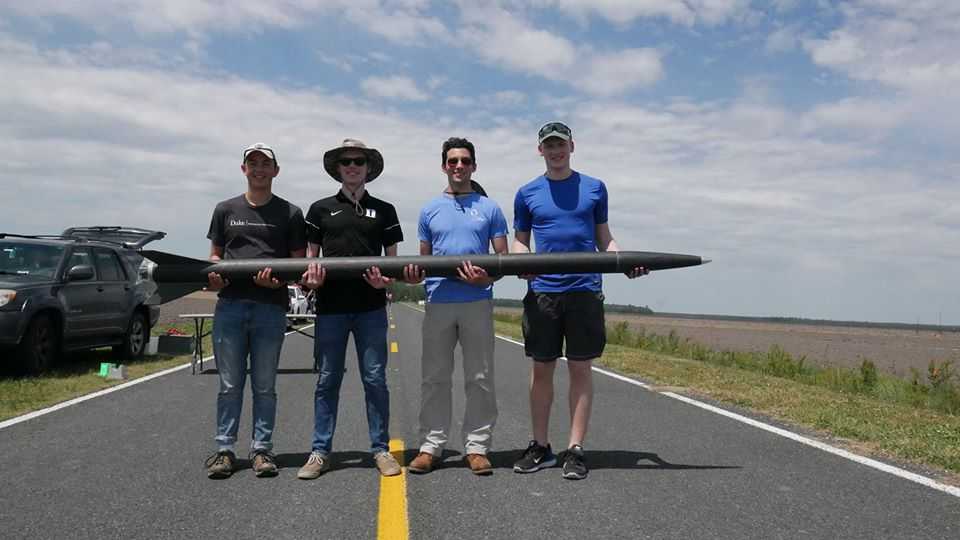
30K COMPETITION (2019-2020)
Shooting to Score at 30,000 Feet
Designed during the 2019/20 academic year for flight at the 2020 Spaceport America Cup, the 30k Competition Rocket was the largest, most powerful vehicle produced by Duke AERO to date. Using a minimum-diameter carbon fiber body tube construction and a commercial-off-the-shelf (COTS) solid motor, every aspect of the rocket was designed for optimal flight with an apogee of exactly 30,000 feet. Featuring a new dual deployment recovery system, not only was the rocket the most powerful vehicle to come out of Duke AERO, but it was the safest with redundancies built in for every critical system. At a length of over 10 feet, the 30k Competition Rocket marked a new era for Duke AERO, one defined by large and powerful rockets in which we carefully refine our abilities to reach orbit. However, due to the COVID-19 pandemic, the launch of this vehicle was delayed, and its design was used as the basis for Coach 30k in 2022.

THING 1 AND THING 2 (2020-2021)
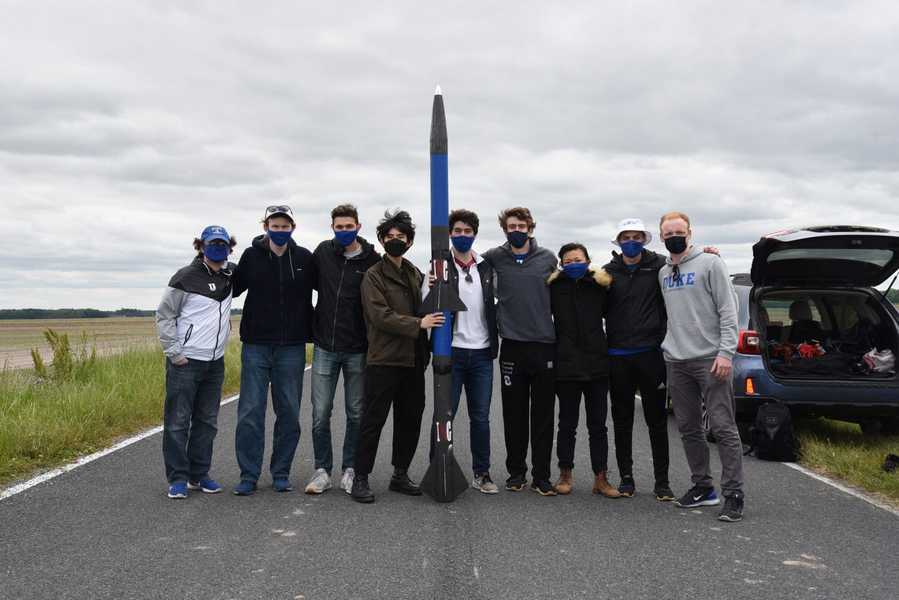
In a year impacted heavily by COVID-19 restrictions that were put in place by the University, Duke AERO took a great leap forward with the development, construction, and successful launch of a two-stage rocket affectionately dubbed “Thing 1 and Thing 2”.
Watch a video of the launch here.
COACH 30K (2021-2022)
EXPLODING BACK TO LIFE
With all students allowed back on campus, the club once again took aim at the Spaceport America Cup 30k COTS challenge. The airframe of the rocket, dubbed “Coach 30k” after former Duke Men’s Basketball Coach Mike Krzyzewski, was 9.38 feet long and had an inner diameter of 4.5 inches. The airframe was made from 2x2 Twill 3k 7oz T-300 Carbon Fiber Fabric, with the exception of the avionics bay which was made from fiberglass. The avionics bay was connected to the forward airframe and the power tube by a polycarbonate coupler. The nosecone was also connected to the forward airframe using a polycarbonate coupler. The rocket had three trapezoidal fins made from a plywood core wrapped with carbon fiber and finished with a tip-to-tip carbon fiber layup. The fins were tabbed for alignment with the internal centering rings. A dual recovery system was implemented with Peregrine 12g CO2 ejection charges for drogue and main parachute deployment. The drogue chute was a 5-foot Rocketman standard parachute, and the main chute was a 14-foot Rocketman standard parachute. The telemetry of the rocket was monitored by a TeleMega altimeter, an RRC3 altimeter, and a Featherweight GPS tracker.
The electronics were powered by two 3.7V LiPo and a 9V alkaline battery and the electronics will be activated using Featherweight magnetic switches. The rocket’s payload experiment investigated the shielding effect of steel against muon penetration at altitude. The enclosure for this experimental project housed three identical muon detectors, each made with a custom PCB and a “SiPM'' PCB. The enclosure also contained a MS5607 Pressure Sensor to convert pressure readings to altitude. The overall rocket design was analyzed using OpenRocket, SolidWorks FEA, and Ansys Fluent. Simulation results were supplemented by ground tests of the recovery and avionics systems.
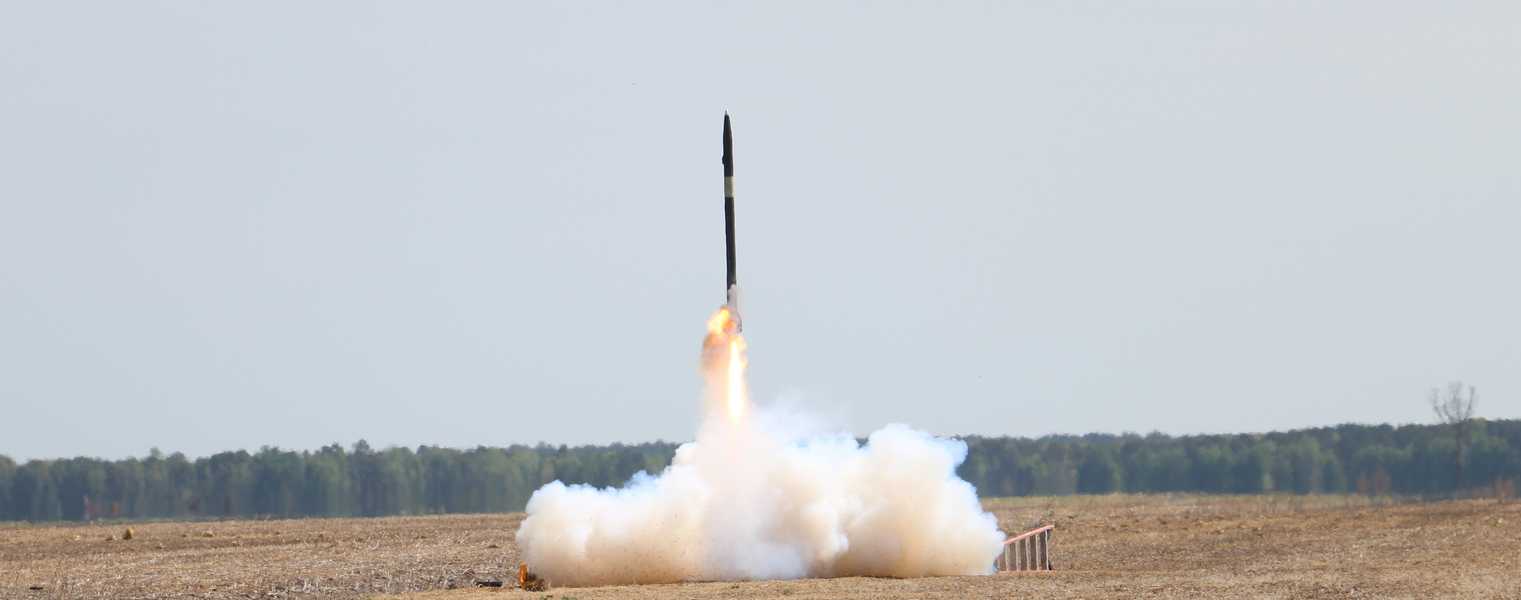
Spaceport America Cup 2022 proved to be a great learning experience for Duke AERO. The day before launch, Coach 30k’s coupling tube cracked beyond repair, and the team had to manufacture a new one overnight. Due to the team’s preparedness by having extra material on hand, the kindness of other teams who lent their tools, and Duke AERO’s determination to stay awake until the job was finished, a new SRAD tube was ready to go the next day, and Coach 30k seamlessly passed safety checks. While the launch did not go as the team had hoped, with telemetry being lost in cloud cover and the target altitude not obtained, Duke AERO was able to celebrate multiple victories: a beautiful launch trajectory off the pad, a CubeSat bonus score, and the recovery of majority of the rocket. Overall, Duke AERO placed 13th in the 30k COTS propulsion category and 69th in all categories. Through SAC 2022, Duke AERO gained valuable competition experience and knowledge as well as new industry relations that would propel the team to a greater caliber of rocketry at the following SAC 2023.
Blue Reaper (2022-2023)
Blue Reaper was a significant leap in technical capabilities from the team’s previous rockets. The rocket is 91.2” tall, and is 6” in internal diameter. The larger inner diameter (as compared to previous years’ 4” internal diameter) was chosen to increase space allowances for payload and advanced avionics. This airframe weighs approximately 64 lbs ready-to-fly on the rail. The rocket utilizes a dual-recovery system, where a small 4’ drogue parachute is housed just aft of the payload, and a large 14’ main parachute is housed aft of the avionics section. Section separation is achieved with two 35-gram CO2 charges per event, mounted in Tinder Rocketry Raptor units. Blue Reaper is powered by an Aerotech M2500T COTS rocket motor.
For the first year, the team developed an innovative 3U CubeSat payload and deployer system actuated at 2,500ft to eject the payload from the rocket. The deployer mechanically retained the CubeSat through flight and apogee until its deployment. Once the CubeSat was deployed, it released a parachute and recorded video until it reached the ground. A seed dispersal system was triggered to simulate interplanetary terraforming operations when it neared the ground.
The team implemented advanced composites to form the rigid structure of the rocket. The airframe was constructed using prepreg carbon fiber sheets to increase ease of manufacturing and increase strength while decreasing weight. Molded carbon fiber was used on the fin mounts and airbrake petals. A two-part fiberglass mold was used to form the composite nose cone. and the nose cone tip was machined in-house.
Blue Reaper contained Duke AERO’s first SRAD flight computer, “Eris.” Eris was developed in-house, using third-party sensors and electronic components. It is controlled by a pair of microcontrollers: a Teensy 4.1 and an Arduino ATMEGA chip. Each chip is designated a certain set of responsibilities to optimize performance in all aspects of flight. The team developed all of the Arduino code placed onto each microcontroller to handle all sensors, flight functions, and airbrake control.
Blue Reaper flew with Duke AERO’s Variable Drag Airbrake System (VDAS) to enable high-precision apogee targeting and showcase the team’s capability to create high fidelity GNC systems. During the coast phase of flight, the system actuates a servo to deploy three forged carbon blades to increase drag and guide the rocket to within one foot of the target apogee. The linear deployment design maximizes drag efficiency while minimizing vertical space required for mechanics within the rocket. The control of the system is a simplified version of model predictive control handled by the Eris Gamma. The team created a modified simulation software in Python, using OpenRocket as the basis for the code. During flight, a series of flight plans is created based on the conditions at burnout, and the computer continuously performs PID control around the chosen flight plan until 10,000 feet.
Integrating the rocket at Spaceport America Cup 2023 proved to be difficult, due to the added challenge of passing wires through the aluminum airbrake housing. Despite these complications, Blue Reaper was launched on the second day of the launch window and had a completely nominal flight. Due to an overly high polling rate in the controls, the airbrake system overestimated the necessary drag and was fully deployed for the entire coast phase. This caused the rocket to fall roughly 1,500 feet short of the target apogee, proving the effectiveness of the airbrakes to cause significant apogee reduction. Blue Reaper had successful separation and parachute deployment at apogee and drogue. Every component was recovered in flight-ready condition, scoring Blue Reaper full recovery points in the competition.
Blue Reaper performed well in its competition category at Spaceport America Cup 2023 and had the fourth highest overall design and build score. Duke AERO celebrated a nominal flight, successful competition, and the design of a rocket built almost entirely in-house.
Pitchfork (2023-2024)
Pitchfork is Duke AERO’s first competition rocket with a solid SRAD motor. It flew in the 10k-ft category at the 2024 Spaceport America Cup. The award-winning rocket is 126 inches tall with an internal diameter of 6 inches. The vehicle weighs 76 pounds ready-to-fly on the rail and deploys two 3U CubeSats. Pitchfork utilizes a dual-recovery system with a small cruciform drogue parachute housed just aft of the payload and a large semi-elliptical main parachute housed aft of the avionics section. Between the avionics and payload systems, Pitchfork contains five sources of telemetry, two runcams, and two live cameras.
The motor affectionately named ‘Marathon’ (being 26.2 lbs fully-integrated) delivered over 11,000 Ns total impulse and used four standard BATES grains. It uses an ammonium-perchlorate composite propellant (APCP) that includes cuprous oxide as a mild burn rate modifier, creating a Duke-blue flame.
Pitchfork also includes the second iteration of Duke AERO’s Variable Drag Airbrake System (VDAS) and third iteration of the team’s SRAD flight computer, dubbed Eris Gamma. VDAS was designed for high-precision apogee targeting to maximize the team’s score in the Spaceport America Cup. This year’s iteration of VDAS contains a similar mechanical system as last year with an updated control system. Rather than generating several possible flight plans at burnout and selecting the best one, this year’s control algorithm generates one more accurate flight path and performs PID control on that path. This algorithm is more efficient and precise than the previous edition of VDAS controls. The controls are still handled by Eris Gamma, which was upgraded to contain better power-handling to account for dual cameras and airbrake servo actuation.
Prepreg carbon fiber manufacturing processes were used to decrease wrinkles and increase uniformity in the weave. Additionally, body tube couplers were made out of fiberglass to create rigid fits between the airframe sections. To decrease weight and move the center of mass lower on the rocket, a forged carbon fiber nose cone tip was molded and mounted on top of the RF transparent fiberglass nose cone. The bulkheads and airbrake housing were optimized for minimal weight.
Pitchfork flies with Duke AERO’s first SRAD parachutes and guided recovery system. The main parachute is a 12’ diameter semi-ellipsoid consisting of 12 Ripstop panels sewn together. The drogue parachute is a cruciform shape attached to servos in the guided recovery system. Guided recovery is controlled by an Eris Gamma SRAD flight computer and relies on data from a magnetometer to perform modified proportion control and steer the rocket to a target location near the launchpad.
The payload is deployed at apogee (10,000 ft) as a 6U unit and separates into two, 3U CubeSats with independent recovery systems. The top CubeSat, Helios, is equipped with a variable reefing parachute system to control descent rate, solar panels and landing legs deployed mid-flight, and the top of the "Lumberjack" system which is used to split the payload into two parts. The bottom CubeSat, Hermes, has its own passively deployed parachute upon separation, grid fins for roll stabilization, and live video feed transmitted to the ground.
Pitchfork includes three strain gauge-integrated fins to measure in-flight fin strains from aerodynamic loading. The system, named FINsight, uses custom printed circuit boards (PCBs) with copper traces that mimic standard strain gauge design. The strain gauges are positioned in optimal locations based on modal analysis performed on the first three fin vibration modes. Each strain gauge on a PCB serves as the fourth resistor in a Wheatstone bridge. Fin deformation caused by aerodynamic loading alters copper trace geometry, causing voltage fluctuations. These fluctuations are processed and recorded via analog-to-digital converters (ADCs) and stored on flash memory. Wind tunnel tests, extensometer experiments, and thermal tests (1) calibrate the system and (2) validate FINsight’s effectiveness as a proof of concept for in-flight fin strain data collection, informing future decisions on fin manufacturing and mounting processes.
The FINsight project was selected for a podium presentation at the 2024 Spaceport America Cup. The team presented on the modal analysis, PCB design, manufacture processes, and data collection methods to judges, sponsors, and other teams. This presentation qualified the team to win a technical award at the competition.
Spaceport America Cup 2024 brought many challenges. Pitchfork was armed on the pad on day one of the launch window, but was recalled due to weather issues. Due to more weather issues and scheduling difficulties, Pitchfork was eventually launched on day three of the window.
An oversight on the main rocket apogee detection system caused the commercial flight computer to trigger separation charges prematurely during flight. This resulted in the full separation of the rocket, causing the forward airframe to cant and do two full loops in the air before the shockcord between the two sections was severed, while the booster continued on an upward flight. All rocket sections were recovered with minimal damage, and the team plans to repair and refly Pitchfork this fall to test all subsystems.
Despite the non-nominal flight, Pitchfork and the Duke AERO team won the Jim Furfaro Award for Technical Excellence. Out of all 152 international collegiate rocketry teams, the judges recognized Pitchfork for having the best overall engineering discipline and skill throughout its design, manufacturing, and integration of its systems. Duke AERO is thrilled to celebrate this accomplishment, and the team plans to continue developing advanced, in-house systems for future competition rockets.
Perseus (2024-2025)
Perseus is Duke AERO’s first 30,000-foot competition rocket powered by a solid SRAD motor. It competed in the 30k-ft category at the 2025 International Rocket Engineering Competition (IREC). Standing 11 ft tall and weighing 125 lbs, Perseus is the largest and most advanced rocket our team has built to date.
Perseus further refines our Variable Drag Airbrake System for altitude regulation and advances our FINsight project, which measures in-flight strain on fins from aerodynamic loading. It also introduces a new, student-designed canard system for active roll control and a blackbox for redundant local telemetry.
At apogee, Perseus deploys a 5U CubeSat, nicknamed Minerva, equipped with a student-designed gimbal camera, live video feed, and safe-landing-spot determination capabilities. Both the rocket and its payload feature guided recovery systems that utilize student-manufactured cruciform parachutes.
The student-designed O-class motor delivers 35,000 Ns of total impulse and 5.8 kN maximum thrust over an 8.4-second burn, propelling Perseus to speeds exceeding Mach 1.5. Like last year’s rocket, it uses an ammonium-perchlorate composite propellant (APCP) with cuprous oxide as a mild burn-rate modifier, producing our distinctive Duke-blue flame.
Keeping with Duke AERO tradition, Perseus was composed almost entirely of student-designed and manufactured components—including fiberglass body tubes, forged-carbon control surfaces, four flight computers, three parachutes, and, of course,an O-class motor.
With Duke AERO’s goal of designing the most technically advanced rocket possible and making everything in-house, it was no surprise that the judges were impressed by Perseus. The judges commented on the complexity of the rocket and the high-fidelity integration of its systems. Other collegiate teams were also eager to hear more about the wide array of systems and projects the team worked on. Duke AERO was among a few teams selected to give a podium presentation on the team’s work! Team members presented on the rocket’s roll-stabilizing canard fins, an advancement very few collegiate teams have accomplished.
After the academic portion of the competition, Duke AERO passed all flight safety reviews and successfully launched Perseus! The rocket exited the rail smoothly and had an excellent motor burn. A minor structural issue caused the rocket to lose stability and undershoot its target apogee, but the team recovered all components of Perseus with minor damage.
Duke AERO is consistently recognized at competition for having advanced, complex, and well-built rockets. IREC 2025 gave students the opportunity to showcase the team’s work, learn from other collegiate rocketry teams, and connect with aerospace industry professionals. The team has already started planning for next year’s rocket and competition, while simultaneously continuing development of its liquid engine program.

